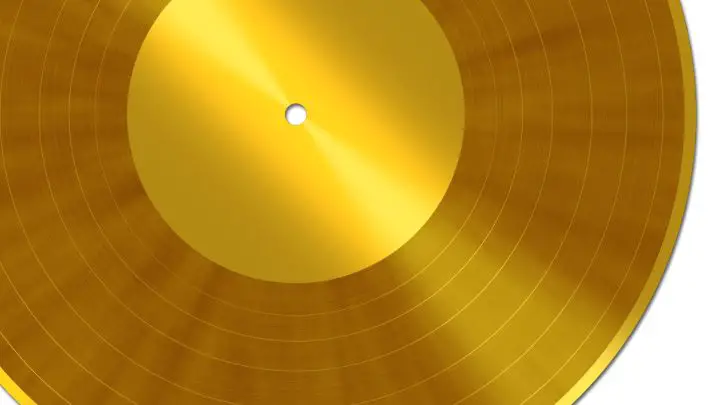In the music business, coveted gold and platinum album certifications represent the pinnacle of commercial success. But what does it actually take for albums to earn these coveted benchmarks? Official RIAA designations now combine physical sales, digital downloads, and streaming unit totals to award these precious metals. However, evolving tech and listening habits raise questions on whether current criteria accurately represent artistic impact. Today let’s clarify the standards for gold and platinum while spotlighting both influential albums reaching these milestones plus challenges certification faces in an uncertain future. Understanding what helps great works earn their “precious metal” luster matters as technology and culture transform.

Table of Contents
- The Criteria for Gold Album Certification
- Historical Milestones: The First Gold Albums
- Gold Albums in Different Genres
- The Impact of Streaming on Gold Album Certification
- Iconic Gold Albums That Defined Generations
- The Process of Verifying and Certifying Gold Albums
- Challenges and Controversies Surrounding Gold Album Certification
- Conclusion: The Future of Gold Albums
- FAQs
The Criteria for Gold Album Certification
Gold certification is a coveted status in the music industry, signifying an album’s commercial success and resonance with listeners. But what does it actually take for an album to go gold? The specific certification criteria depend on the country and certifying organization – in the US, that responsibility falls to the Recording Industry Association of America (RIAA).
Sales Figures Needed for Gold
To earn RIAA gold certification, an album must sell 500,000 units. Originally, these units consisted solely of physical album sales. As technology has shifted music consumption, the RIAA now includes on-demand audio and video streams and digital downloads in addition to physical sales.
100 on-demand audio or video streams from services like Spotify or YouTube counts as one unit, as does a digital download. This expansion to include streaming occurred in 2016, making it easier for modern artists releasing singles rather than full albums to still reach gold status. However, physical sales still make up a meaningful chunk of units for many popular albums.
The Role of the RIAA in Certification
The RIAA serves as the certifying organization for album awards in the US. Record companies must pay a fee and submit audited sales figures and streaming data to apply for certification. An RIAA representative will then review and verify the information before awarding certification at benchmark levels like gold and platinum.
The RIAA introduced its album award program in 1958 to celebrate commercial success. Over time, they have adapted the program’s unit totals and formulas to account for changes in music industry business models. But the prestige and significance of earning a gold, platinum or diamond certification remains substantial for artists.
Global Certification Criteria
While the RIAA handles certification in the US, other countries rely on their own phonographic industry organizations. For example, the British Phonographic Industry (BPI) handles UK certifications. The threshold for gold status varies globally – in the UK, gold certification requires sales of 100,000 units while in Germany gold represents sales of 150,000 units.
So an internationally popular artist may earn certification at different awards levels in multiple countries. The International Federation of the Phonographic Industry (IFPI) represents these national groups, working to standardize reporting methodologies globally.
Certification in the Streaming Era
Incorporating streaming into certification criteria has helped adapt music awards to an industry increasingly focused on streaming. This allows recognition of the popularity and impact that viral hits and extensively streamed songs and albums achieve.
But concerns linger on how streams are weighted – whether 100 streams should equal one download or physical sale. The IFPI and national organizations continue evaluating how to shape certification to accurately represent commercial success. But for now, combining streams and sales provides a reasonable picture of albums earning gold based on fan consumption.
Historical Milestones: The First Gold Albums
When the Recording Industry Association of America (RIAA) first introduced album certifications in 1958, it ushered in a new way for artists to benchmark success. Those first albums to reach the then-500,000 sales threshold for gold set precedents for commercial triumph. They also demonstrated that the public would buy full-length albums, not just singles. Let’s look back at some key gold albums that shaped music history.
Frank Sinatra Starts Strong
Fittingly, the very first gold album certification went to Ol’ Blue Eyes himself. Frank Sinatra’s 1958 LP Come Dance with Me sailed past 500,000 sales just four months after release. Sinatra had ushered in innovative album concepts with previous works like Songs for Young Lovers. Come Dance with Me built on that, with Billy May’s swinging arrangements behind Sinatra’s vocals. Its success proved Sinatra’s lasting appeal and showed that albums themselves could become blockbuster hits.
Original Broadway Casts Strike Gold
In the early 1960s, original cast recordings from smash Broadway musicals like The Sound of Music and My Fair Lady achieved gold (and later platinum) sales. These surprise commercial juggernauts demonstrated the public’s demand for full musical theater recordings. Critical acclaim certainly helped – The Sound of Music won the 1960 Grammy Award for Best Musical Theater Album. But the gold certifications signified that Broadway’s cultural relevance now translated into profitable business as well.
Simon & Garfunkel’s Breakthrough
Folk rock duo Simon & Garfunkel had struggled on the charts – until the 1965 release of the soundtrack for The Graduate film. That album spent 85 weeks on the charts on the way to selling over a million copies. As both a hugely popular movie and standout album, it marked Simon & Garfunkel’s commercial breakthrough. The poignant tunes and lyrical songwriting on tracks like “Mrs. Robinson” and “The Sound of Silence” resonated widely. In doing so, the album helped bring folk rock into the mainstream evening winning the Grammy Award for Album of the Year in 1969.
The Eagles Soar with Their Greatest Hits
Greatest hits albums offer bands a chance to earn certification by compiling their most popular songs. The Eagles found enormous success with just that. Their 1976 compilation Their Greatest Hits (1971–1975) packaged all five of the band’s Top 40 singles alongside rock radio staples like “Peaceful Easy Feeling” and “Tequila Sunrise.” The album went platinum 29 times over, making it the best-selling album in US history. Its runaway popularity proved the commercial potential of greatest hits LPs as solid moneymakers – if the band has enough hits.
Gold Albums in Different Genres
While pop, rock, and rap albums frequently dominate the charts, albums spanning many genres have achieved gold or platinum status over the years. Let’s explore some landmark certified albums across country, Latin, reggae and other styles beyond the charts’ usual focus.
Country Classics Going Gold
Country music has celebrated its share of gold and platinum albums, led by classic LPs like Shania Twain’s Come On Over (12x platinum) and Garth Brooks’ No Fences (17x platinum). Even legendary country artists have achieved gold despite lacking major mainstream radio play. Johnny Cash’s 1976 album Greatest Hits went gold, fueled by stripped-back classics like “Folsom Prison Blues.” Willie Nelson’s album Stardust featured pop standards – it hit gold in 1978. These benchmark albums showed country could drive profitable sales even if lacking major singles.
Latin Crossovers Finding Success
Latin pop has frequently crossed over to mainstream success, with hitmakers like Gloria Estefan and Ricky Martin earning gold albums full of infectious dance tunes. Selena’s English-language album Dreaming of You went gold after topping the 200 Billboard after the young Tejano star’s tragic death. In the 2000s, crossover sensations like Shakira (Laundry Service hit platinum) and Enrique Iglesias made Latin-flavored pop a global phenomenon, achieving gold and platinum albums in the process.
Reggae Legends Joining the Gold Club
Bob Marley stands tall as reggae’s greatest global ambassador, with Legend hitting platinum. But other landmarks of the genre have also reached gold status in America. Jimmy Cliff’s The Harder They Come soundtrack brought reggae sounds to US listeners, going gold in 1973 even with just modest radio play. And despite facing little mainstream visibility, Burning Spear’s classic 1976 album Marcus Garvey, Steel Pulse’s 1979 LP Tribute to the Martyrs, and Black Uhuru’s Red all certified gold solely on the strength of grassroots sales.
Jazz Greats Earning Their Gold Records
Jazz albums scoring big sales is a rarity given the genre’s complex, cerebral leanings. But some standout LPs have still managed to snag gold plaques. Miles Davis’ 1959 LP Kind of Blue is regarded as the greatest jazz album ever – it went quad platinum despite no radio singles. Herbie Hancock hit gold with his 1973 funk opus Head Hunters. And spouse duo Tuck and Patti saw their 1988 live album Tears of Joy also turn gold through grassroots jazz fan support and critical acclaim.
The Gold Album Benchmark Across Genres
Genres from Americana (The Eagles) to New Age (Enya) have managed to yield hugely popular albums that went gold or better. But rock, pop and hip hop still dominate the upper reaches of certification simply due to their mainstream visibility and radio play. An album going gold takes an alchemy of great songs and relentless promotion. But diverse releases reaching that sales mark proves great music succeeds regardless of genre limitations when connecting with fans.
The Impact of Streaming on Gold Album Certification
The advent of music streaming services like Spotify and Apple Music has profoundly impacted how albums reach gold or platinum status. As listening habits shift to streaming, certification criteria have adapted to include factors like track streams and playlist placements. The streaming boom has provided new opportunities for recognition, but has also raised questions around how streams get counted.
Streaming Services Surpass Physical Sales
Music streaming now accounts for the majority of music industry revenues. Streaming services have surged past physical album and digital download sales. In 2015, on-demand audio streams first outpaced song downloads for the first time. Just a year later, the RIAA began incorporating select streams alongside album sales to determine gold and platinum certifications.
With streaming’s growth, an album going viral on Spotify or topping Apple Music’s charts can drive huge numbers of streams. Portrayal of a Life by $uicideboy$ earned gold certification in 2022 based mainly on streams – it had under 3,000 pure album sales. Platform playlists also play a key role in driving streams for both new and catalog albums.
Weighing Streams vs. Sales
When the RIAA began counting streams, it determined that 1,500 on-demand audio or video streams would equal one album unit. After feedback from music industry stakeholders, this ratio changed in February 2016 to the current rate of 100 streams equivalent to one unit.
But concerns still remain onweighting. Does a stream indicate the same amount of listening intent as a full album purchase? Experts debate whether 100-to-1 matches how fans consume albums versus singles in the streaming environment. The metrics continue being discussed as consumer behavior and tech evolves.
Gatekeeping Power of Playlisting
Playlist placements on Spotify and other services can play a pivotal role in driving streams. Topping Spotify’s “New Music Friday” or an Apple Music editorial list lends albums visibility to drive certification-counting streams. But these coveted spots carry huge competition.
That gatekeeping power means certification luck may depend on curatorial decision makers. Genres like jazz that lack mainstream visibility on big playlists have a tougher time reaching gold album status. Playlist promotions also influence earlier catalog – for example, appearances on Spotify’s throwback themed “Peaceful Piano” helped several new age albums reach gold years after release.
Certification Still Denotes Success
Reaching certification thresholds now depends as much on streaming luck as traditional album purchases. Factors like viral song sharing on TikTok or earning a celebrity co-sign to drive streams are part of the equation.
But despite format changes, gold and platinum plaques still signify the resonance and popularity of albums amongst music fans. In the end, high stream counts still require listener intent even if less tied to purchases. Certification remains a goal for artists even as how fandom gets calculated shifts with technology platforms.
Iconic Gold Albums That Defined Generations
While countless albums achieve commercial success, only a select few make such an enduring impact that they shape future music and popular culture itself. These gold and platinum works often transcend their eras to become truly iconic. Let’s explore some generation-defining records.
The Beatles Usher in 60s Counterculture
The Beatles didn’t just impact music – they impacted history. Their 1969 LP Abbey Road sold over 12 million US copies and inspired countless artists with envelope-pushing studio techniques. But 1967’s Sgt Pepper’s Lonely Hearts Club Band proved their most generation-defining work. The stylistic ambition matched the Summer of Love counterculture explosion. Psychedelic gems like “Lucy in the Sky with Diamonds” remain fixtures of 60s spirit. From music to fashion to philosophy, Sgt Pepper’s captured a seismic shift in zeitgeist.
Thriller Takes Pop to New Heights
Already a star in the Off the Wall era, Michael Jackson’s 1982 epic Thriller propelled him into the pop stratosphere. Infusing R&B and rock with filmic ambition, Thriller broke racial barriers on MTV and became the first album certified 30x platinum. But beyond sales records, Thriller revolutionized the scale of pop superstardom and spectacle. Lavish videos and stage theatrics became expectations for event pop stars following in MJ’s stardom mold from Janet Jackson to Lady Gaga and beyond.
Nirvana Spearheads Alternative Explosion
When grunge roared from Seattle garages to dominate early 90s rock radio, Nirvana led the charge. Their 1991 sophomore LP Nevermind and its breakout single “Smells Like Teen Spirit” crashed the mainstream as alternative conquered the musical landscape. Nevermind opened doors for the genre while Cobain’s songwriting and fashion cemented grunge’s place as Gen X counterculture. Artists from Smashing Pumpkins to Soundgarden earned fame in Nirvana’s wake. But no group better catalyzed the alternative revolution.
Lauryn Hill Molds Future R&B Visionaries
Arriving amid 90s hip hop’s golden age, the 1998 solo debut The Miseducation of Lauryn Hill bowed at #1 and eventually sold over 20 million copies globally. Blending old-school soul with cutting-edge beats, Miseducation set a template for genre-fluid R&B excellence. Just as importantly, Hill’s confessional lyrical vulnerability on tracks like “Ex-Factor” created space for artists like Frank Ocean to explore personal perspectives. Two decades later, Miseducation’s influence only grows.
Crossover Country Classics
Country stars reaching mainstream success is no surprise today. But artists like Taylor Swift and Kacey Musgraves stand on the shoulders of crossover LPs that preceded them. The Eagles fused country rock for mass appeal through smashes like Their Greatest Hits. Shania Twain made country colourfully pop-friendly with 1997’s 12x platinum Come On Over. Expanding country’s bounds through visionary fusions, these benchmark LPs paved the way for the genre’s current pop synergies. Mainstream country acceptance owes them a debt.
The Process of Verifying and Certifying Gold Albums
The path to an album getting certified gold or platinum begins long before an artist even enters the recording studio. It takes coordinated efforts between labels, industry organizations, and artists’ teams to eventually hit certification thresholds. Let’s explore what’s involved behind the scenes.
Early Projections by Labels
Well before an album release, record labels use analytics tools and insider expertise to forecast potential sales and streaming traction. Factors like an artist’s past performance, tour ticket sales, and early single success provide clues. Labels use these projections to orient certification around a “planned gold/platinum date” for celebrations.
Of course, unpredictability abounds – many albums fall short while surprise smashes exceed expectations. But labels leverage all available data to establish benchmarks. Doing so provides tangible targets for marketing campaigns to propel albums towards certified status.
Submitting for Certification Consideration
Once an album actually drops, labels monitor performance daily across sales and streaming reports. After benchmark thresholds for certifications get crossed, labels complete required paperwork to formally submit for consideration. This includes paying a per-album fee and providing extensive audited sales data.
For example, all the audit paperwork verifying 500,000 album units for a gold submission gets presented to certifying organizations like the RIAA. An approval team thoroughly examines details before ultimately awarding certification if merited. The full verification process typically takes several weeks after labels submit paperwork.
Celebrating Success with Artists & Fans
Once the RIAA or similar organizations grant certification, announcement press releases follow quickly. Labels and publicists leverage the news into positive press and social media celebration. Artists share excited reactions with fans.
Finally, the coveted plaques themselves ship – that iconic gold (or platinum/diamond) disc to proudly display. So while data and dollars add up quietly on spreadsheets for months, certification becomes a public-facing win to toast an artist’s continued success. Fans and industry peers offer congratulations on achieving a significant milestone. And the commercial triumph gets memorialized permanently in music history.

Challenges and Controversies Surrounding Gold Album Certification
While most albums reaching gold or platinum status pass verification without issues, some certifications have proven controversial. Debates have emerged around cases of questionable album unit totals getting confirmed by the RIAA and similar organizations. Let’s explore some disputed certifications and their implications.
Vanilla Ice’s Fast Gold Certification
Vanilla Ice’s 1989 track “Ice Ice Baby” became a smash hit. But the subsequent album To the Extreme raced to US gold certification after just six weeks, raising eyebrows. Critics charged that Ice’s label, SBK Records, had bolstered sales by purchasing albums itself – a tactic viewed as manipulation. While legal, it sparked discussion on certification safeguards.
Audits and Monitoring for Accuracy
In the wake of controversies like Vanilla Ice’s certification, the RIAA pledged to enhance auditing standards for both labels and internal verification teams. The goal became spotting any red flags around bulk purchases or bot streams potentially skewing unit totals. While not flawless, the updated process provided better oversight and consequences for certification accuracy.
By the 2000s, hip hop artists got ensnared by updated procedures – 50 Cent had a platinum plaque revoked while Nelly’s sweat towels no longer bundled toward sales. The crackdowns demonstrated tightened vigilance to uphold certification integrity. But suspicion still lingers in some cases.
Hard Rock Band Suddenly Goes Metal
Hard rock band Staind scored multiplatinum success in the early 2000s before their popularity waned. But their lesser-known 2011 album Staind went metal surprisingly surpassed gold status quickly in an unlikely sales resurrection.
However, no tour or promotion supported this burst. Rather than pure sales, rumors floated that the label purchased enough albums itself to trigger gold certification before Billboard rules changed to prevent such tactics.
Calls for Transparency Around Certification
While many cases like Staind’s 2011 status remain ambiguous, it’s clear that certification requires artists’ teams and music organizations to actively eliminate loopholes. Modern data tracking provides more sales verification but still allows gaming the system.
That’s why luminaries like former Sony Music CEO Don Ienner have argued for radical transparency around certification audits. Letting the public itself view the data around disputed cases could bolster process integrity. More openness would clarify certification’s accuracy in quantifying artistic success.
Conclusion: The Future of Gold Albums
Since the RIAA introduced certification in 1958, the music industry and the criteria for awards like gold and platinum statuses have significantly evolved, reflecting the shift from physical sales to streaming. The future of these certifications hinges on their ability to adapt to changing music consumption patterns. Industry bodies have already expanded their criteria to include streaming, indicating their willingness to evolve with technology. As music listening habits continue to change, with potential shifts towards more interactive and engagement-based metrics, we can expect further adjustments to how success is measured and celebrated.
Emerging platforms could also play a significant role in the evolution of certification criteria. Innovations such as a possible standalone streaming app from TikTok or artists creating exclusive content through tokens might introduce new ways to gauge fan engagement and quantify success. Such changes would prompt certifying bodies to adapt their criteria to maintain the relevance of these awards by accurately reflecting genuine cultural resonance.
Despite the ongoing changes in the industry, the prestige associated with gold and platinum certifications remains undiminished. Artists, from seasoned superstars to recent breakthroughs, continue to value these symbols of commercial success and fan support. The desire for recognition, coupled with the awards’ ability to adapt to the industry’s evolution, ensures that gold and platinum statuses will retain their importance. These certifications not only honor commercial achievement but also signify a deep, enduring connection with listeners, transcending the specifics of how music is consumed.
FAQs
How does an album go gold?
An album goes gold by meeting the certification criteria set by the recording industry of a country, such as selling 500,000 copies in the United States, as defined by the Recording Industry Association of America (RIAA). This includes both physical sales and digital streams, where a certain number of streams equate to one album sale, according to the certifying body’s guidelines.
What is better platinum or Gold album?
A platinum album is considered higher in prestige than a gold album. It signifies greater commercial success, requiring the sale of 1 million copies in the United States, compared to the 500,000 copies needed for gold certification by the RIAA.





